Leea nova-guineensis
Leea nova-guineensis, commonly known as bandicoot berry, is a plant in the family Vitaceae native to parts of Malesia and Oceania.
| Bandicoot berry | |
|---|---|
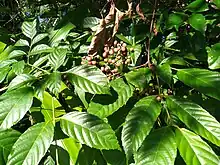 | |
| Foliage and fruit, Cairns, Queensland | |
| Scientific classification | |
| Kingdom: | Plantae |
| Clade: | Tracheophytes |
| Clade: | Angiosperms |
| Clade: | Eudicots |
| Clade: | Rosids |
| Order: | Vitales |
| Family: | Vitaceae |
| Genus: | Leea |
| Species: | L. nova-guineensis |
| Binomial name | |
| Leea nova-guineensis | |
| Synonyms[3] | |
|
Leea gracilis Lauterb. | |
Description
The bandicoot berry is an evergreen shrub which usually grows to about 4 m (13 ft) high, but can occasionally be taller.[4][5] It is a multistemmed plant with large tripinnate leaves measuring up to 1 m (3 ft 3 in) long, while the individual leaflets measure up to 21 cm (8.3 in) long by 9 cm (3.5 in) wide.[4][5] The stipules are quite large and may be up to 6 cm (2.4 in) long>[4] Flowers are produced in either terminal or leaf-opposed panicles.[5] They are quite small, around 3 mm (0.12 in) long, with five green or cream petals.[4][5] The fruit is a red, purple or black berry up to 15 mm (0.59 in) diameter.[4][5]
Taxonomy
This plant was originally considered to be part of a very widespread population of Leea indica, however in 1907 the Dutch botanist Theodoric Valeton published a paper in which the plants of Malesia, Australia and the southwest Pacific were renamed as Leea nova-guineensis.[6] Much later, in 2012, a paper was published in which this species was given the new combination Leea novoguineensis,[7] which is recognised by Australian authorities,[1][2][4][8] but not by Plants of the World Online.[3]
Distribution and ecology
Leea nova-guineensis grows as an understory plant in rainforest, at elevations from sea level to 400 m (1,300 ft).[4][5] It is native to the Lesser Sunda Islands, the Maluku Islands, New Guinea, the Bismark Archipelago, the Santa Cruz Islands, the Solomon Islands, Vanuatu, and the states of the Northern Territory and Queensland in Australia.[3][4]
The fruit are reported as being eaten by Wompoo fruit doves.[5]
Conservation
This species is listed by the Queensland Department of Environment and Science as least concern.[1] As of 9 July 2023, it has not been assessed by the International Union for Conservation of Nature (IUCN).
Gallery
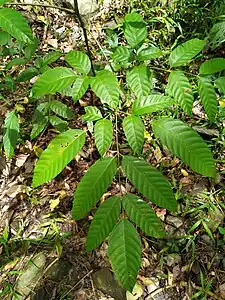 Tripinnate leaf
Tripinnate leaf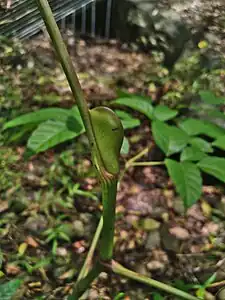 Large stipule
Large stipule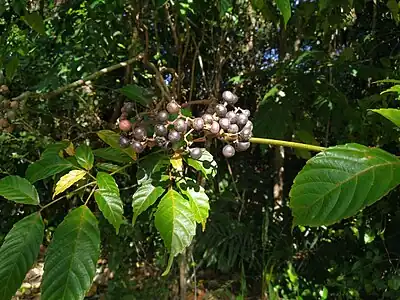 Ripening fruit
Ripening fruit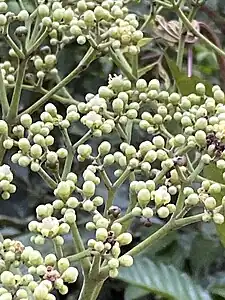 Inflorescence
Inflorescence
References
- "Species profile—Leea novoguineensis". Queensland Department of Environment and Science. Queensland Government. 2022. Retrieved 9 July 2023.
- "Leea novoguineensis". Australian Plant Name Index (APNI). Centre for Australian National Biodiversity Research, Australian Government. Retrieved 9 July 2023.
- "Leea nova-guineensis Valeton". Plants of the World Online. Royal Botanic Gardens, Kew. Retrieved 9 July 2023.
- F.A.Zich; B.P.M.Hyland; T.Whiffen; R.A.Kerrigan (2020). "Leea novoguineensis". Australian Tropical Rainforest Plants Edition 8 (RFK8). Centre for Australian National Biodiversity Research (CANBR), Australian Government. Retrieved 9 July 2023.
- Cooper, Wendy; Cooper, William T. (June 2004). Fruits of the Australian Tropical Rainforest. Clifton Hill, Victoria, Australia: Nokomis Editions. p. 268. ISBN 9780958174213.
- Valeton, Theodoris (1907). "Plantae papuanae". Bulletin du Département de l'Agriculture aux Indes Néerlandaises. 10: 31. Retrieved 11 July 2023.
- Molina, Jeanmaire E.; Wen, Jun; Struwe, Lena (2013). "Systematics and biogeography of the non-viny grape relative Leea (Vitaceae)". Botanical Journal of the Linnean Society. 171 (2): 354–376. doi:10.1111/j.1095-8339.2012.01320.x.
- "Leea novoguineensis". Flora of Australia. Australian Biological Resources Study, Department of Climate Change, the Environment and Water: Canberra. 2022. Retrieved 12 July 2023.
External links
 Data related to Leea nova-guineensis at Wikispecies
Data related to Leea nova-guineensis at Wikispecies Media related to Leea nova-guineensis at Wikimedia Commons
Media related to Leea nova-guineensis at Wikimedia Commons- View a map of historical sightings of this species at the Australasian Virtual Herbarium
- View observations of this species on iNaturalist
- View images of this species on Flickriver